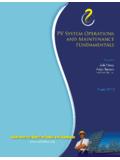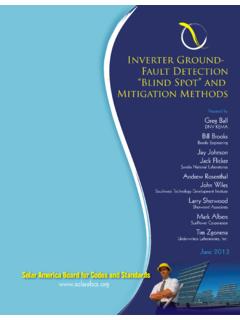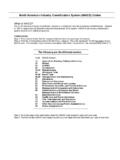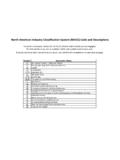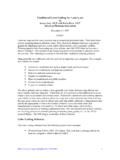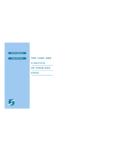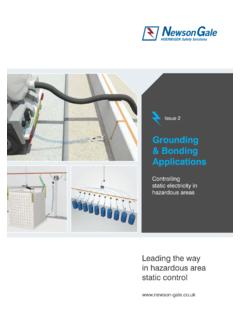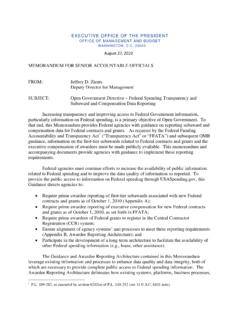Transcription of Prepared by Solar America Board for Codes and …
1 Fire classification Rating Testing of Stand-Off Mounted Photovoltaic Modules and Systems Prepared by Larry Sherwood Solar America Board for Codes and standards Bob Backstorm Dwayne Sloan Christopher Flueckiger Underwriters Laboratories Bill Brooks Brooks Engineering Andrew Rosenthal New Mexico State University August 2013. Solar America Board for Codes and standards DISCLAIMER. This report was Prepared as an account of work sponsored by an agency of the United States government. Neither the United States government nor any agency thereof, nor any of their employees, makes any warranty, express or implied, or assumes any legal liability or responsibility for the accuracy, completeness, or usefulness of any information, apparatus, product, or process disclosed, or represents that its use would not infringe privately owned rights. Reference herein to any specific commercial product, process, or service by trade name, trademark, manufacturer, or otherwise does not necessarily constitute or imply its endorsement, recommendation, or favoring by the United States government or any agency thereof.
2 The views and opinions of authors expressed herein do not necessarily state or reflect those of the United States government or any agency thereof. Download a copy of the report: 2 Solar America Board for Codes and standards Report EXECUTIVE SUMMARY. The year 2013 marks a significant change for the fire classification rating approach for roof mounted stand-off photovoltaic (PV) modules and panels evaluated in accordance with American National standards Institute/Underwriters Laboratories, Inc. (ANSI/UL) 1703, Standard for Safety for Flat-Plate Photovoltaic Modules and Panels. Prior to 2013, a PV module manufacturer could receive a fire classification rating based on tests of the module or panel alone. After the 2013. changes to ANSI/UL 1703, the fire classification rating approach takes into account the module or panel in combination with the mounting system and the roof covering products over which it is installed. The proposals that led to these changes were an outgrowth of research tests conducted and broad stakeholder forums held through a partnership between UL and the Solar America Board for Codes and standards ( Solar ABCs).
3 Throughout this report, ANSI/UL 1703-2012 (ANSI/UL, 2002) refers to versions of UL 1703 with a revision date of May 8, 2012 or earlier. ANSI/UL 1703-2013 refers to the new edition of UL 1703 that incorporates the new fire classification test described in this report. Around 2009, it became apparent that fire and code officials and the Solar indus- try had concerns about the installation of lesser class-rated PV modules (Class C). over higher class-rated roofs (Class A). Although both roof covering materials and PV modules received fire class ratings, little work had been done to investigate the interactions between them when systems composed of PV modules mounted in stand-off configuration over roofing systems are exposed to burning materials or flame. Specifically, it was necessary to investigate whether and how PV modules with Class B or C fire ratings may adversely affect the performance of Class A. rated roofing systems. To investigate these concerns, Solar ABCs and UL conduct- ed extensive tests on various combinations of PV designs and roof coverings, and explored some mitigation techniques.
4 During early research testing, various spread of flame test experiments were per- formed with Class A and Class C rated PV modules mounted in combination with Class A roof products and systems. The results in all cases showed flame propaga- tion well beyond the ANSI/UL 1703-2012 Class A requirement of six feet within a fraction of the typical test time duration. Experiments were also performed to examine a burning item coming to rest between the PV and the roof, or the igni- tion of accumulated leaves or debris. Testing showed that Class A rated PV mod- ules mounted at a typical five-inch gap height did not comply with Class A require- ments when the burning brand was placed on the roof below the modules. When this test was performed using Class C modules, the test results were inconclusive. Finally, initial testing found mitigation techniques that showed promise in prevent- ing the degradation of roof covering fire class rating by rack-mounted PV modules.
5 The research tests demonstrated that fire class rating of the PV module alone de- termined according to ANSI/UL 1703-2012 may not predict the fire performance of the PV module, mounting system, and roof assembly as a system. From a safety perspective, the objective of the work turned towards promoting stand-off-mount- ed PV systems with improved performance and developing a system-based test that would differentiate high performing from low performing designs. Thus, the stakeholders and investigation team decided to pursue the development of a new fire classification test for the PV module, the mounting components, and the roof assembly as a system. Fire classification Rating Testing of Stand-Off Mounted Photovoltaic Modules and Systems 3. During the steps towards development of a new fire classification test, the team considered the real world scenario in which the roof ignites first and then the flames develop and migrate underneath the PV panel to present a fire exposure challenge to the PV system.
6 This concept of first to ignite, second to ignite sequence is well established in the fire protection community, and was proposed as the best way to properly evaluate a PV module in the presence of a roof covering. In all the research tests prior to this concept, the PV module was installed in a position where both the roof and the module were subjected to the ignition source with zero offset or with only modest offset distances (24 inches or less). from the flame source. At the beginning of these tests, the test flame was already extending well into the gap between the module and the roof. However, with a first to ignite, second to ignite test, the PV is installed for test with a setback such that the roof covering ignites first, the fire propagates along the roof, and then the PV. module is exposed. This concept was tested in a number of validation tests. These experiments led to a new fire classification test, which is a significant change from the previous PV module fire classification test procedure.
7 In the new procedure, the module is tested mounted over representative roof covering systems and the performance of the entire system is the basis for the fire classification rating of the PV module with mounting system. In this manner, the new PV fire classification test provides a more useful rating than the previous PV. module-only rating test. The new requirements in ANSI/UL 1703-2013 include an optional characteristic testing of PVs, tested alone in a similar manner to ANSI/UL 1703-2012. This characterization was maintained because this information can prove useful in demonstrating grouping of PVs into types in an effort to satisfy the ANSI/UL. 1703-2013 requirements for the classification rating as a system. The new fire classification rating tests in ANSI/UL 1703-2013 involve the combination of the module or panel, the mounting system, and the roof covering system. Because each of these three components has many products in the marketplace, testing every possible combination of the three components could mean thousands of required tests.
8 This is not practical and could stifle market innovation. In response, a number of considerations and provisions were written into the new standard to reduce the number of required tests. In addition, Solar ABCs, UL, industry, and stakeholders continue to explore and validate industry- wide solutions that may satisfy the new, revised ANSI/UL 1703-2013 fire classification requirements in an effort to reduce the industry's testing burden. Solar ABCs is a collaborative effort among experts to provide coordinated recommendations to Codes and standards -making bodies for existing and new Solar technologies. UL provides safety and performance testing and product certifications for thousands of materials and products. UL is also a leading safety standard development organization. UL was a pioneer in the evaluation and testing of roof covering materials ( , shingles) and PV modules. 4 Solar America Board for Codes and standards Report AUTHOR BIOGRAPHIES.
9 Bill Brooks Brooks Engineering Bill Brooks has worked with utility-interconnected photovoltaic (PV) systems since the late 1980s. He is a consultant to the PV industry on a variety of performance, troubleshooting, and training topics. During the past 15 years, his training workshops have helped thousands of local inspectors, electricians, and installers understand and properly install PV systems. His field troubleshooting skills have been valuable in determining where problems occur so that training can focus on the issues of greatest need. He has written several important technical manuals for the industry that are now widely used in California and beyond. His experience includes work on technical committees for the National Electrical code Article 690. and IEEE utility interconnection standards for PV systems. In 2008, the Solar Energy Industries Association appointed him to code Making Panel 4 of the National Electrical code . He holds bachelor and master of science degrees in mechanical engineering from North Carolina State University and is a registered professional engineer in both North Carolina and California.
10 Andrew Rosenthal Southwest Technology Development Institute, New Mexico State University Andrew Rosenthal is Director of the Southwest Technology Development Institute, College of Engineering at New Mexico State University in Las Cruces, New Mexico. He is responsible for management of the U. S. Department of Energy's Southwest Region Photovoltaic Experiment Station. Among his duties are supervising the work of ten engineers and making regular presentations to scientists from DOE, Sandia National Laboratories, and state and federal agencies. In addition to management activities, his engineering activities include interfacing with major utility companies for implementation and review of district-wide renewable energy programs, designing data acquisition systems for photovoltaic (PV) power systems, training designers and installers of PV systems, PV performance and acceptance field tests, and preparing technical and economic analyses of renewable energy programs for public and private clients.

